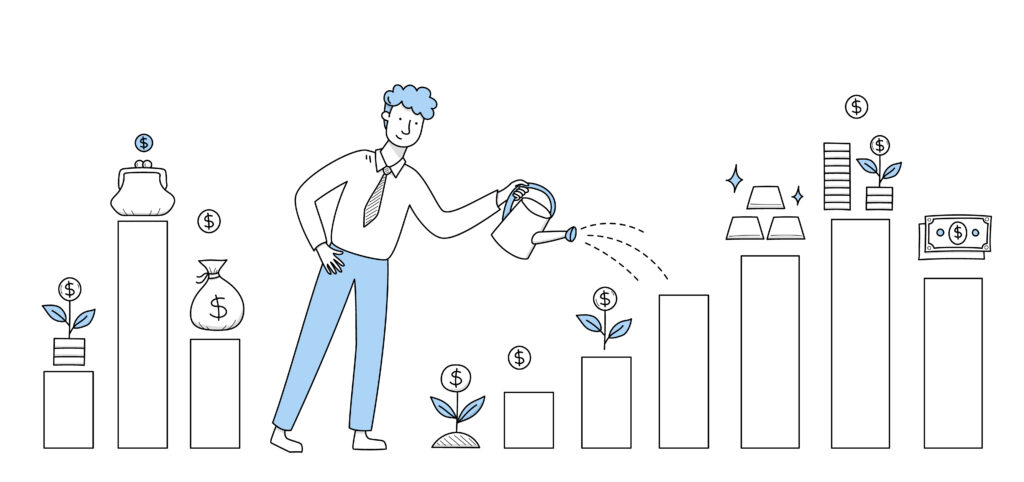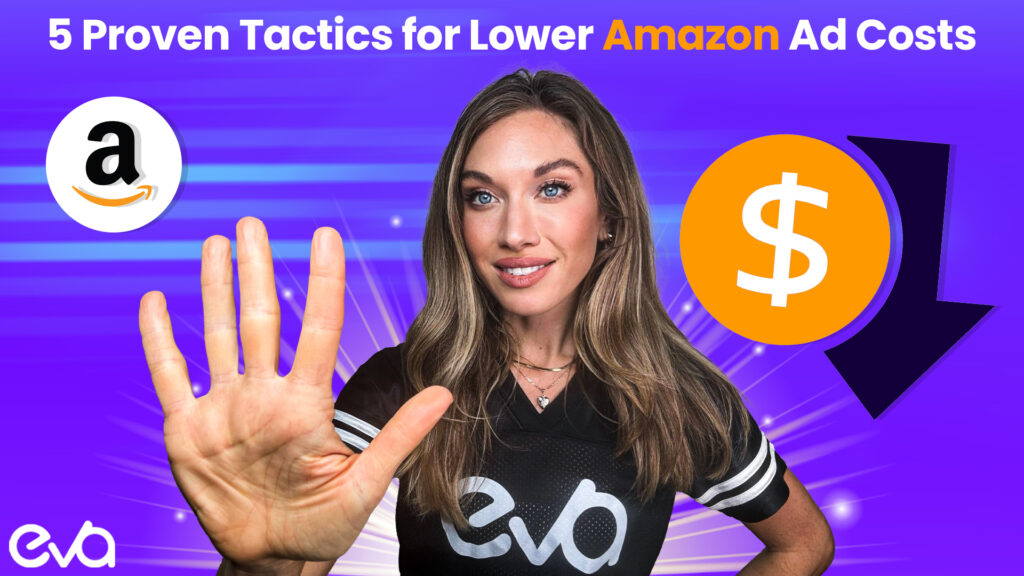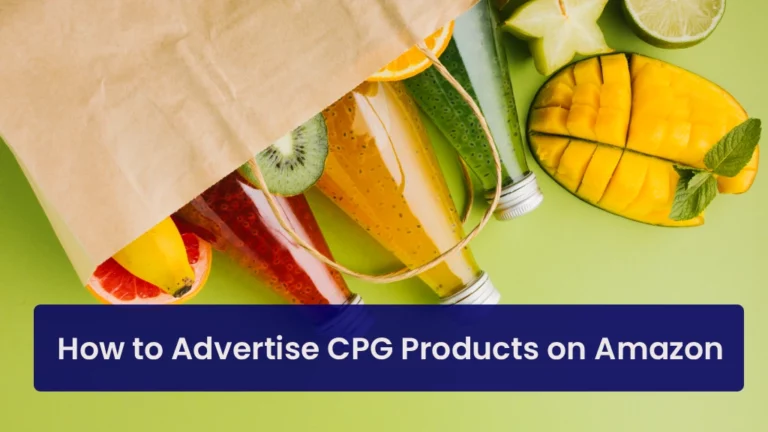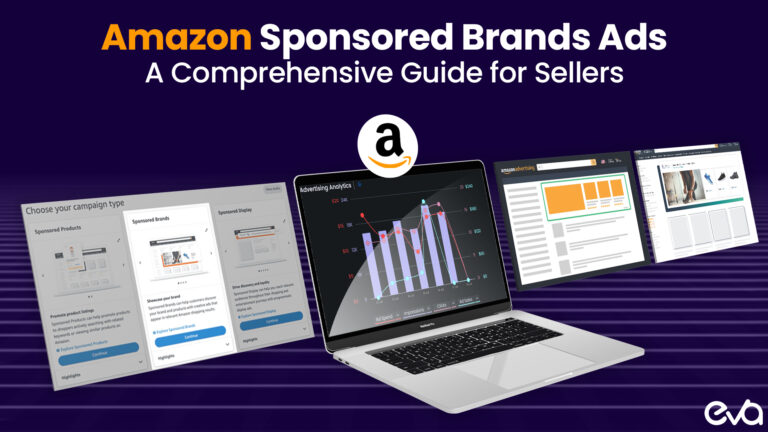Ask an Amazon PPC expert what’s at the top of their wishlist and the odds-on favorite would probably involve finding a way to improve their Amazon ACoS (advertising cost of sale).
After all, the lower your Amazon PPC cost, the more profitable your business is likely to be. This blog takes a close look at the latest, proven strategies to decrease your Amazon ACoS without sacrificing ad performance.
Keep reading to learn more about how fine tuning your Amazon ads campaign might involve a more holistic view of your overall marketing goals.

Discover How To Supercharge Your Profits From Amazon & Beyond
Tech – unlock more revenue, increase efficiency & maximize profitability with integrated AI solutions
Agency Services – our ex-Amazonian team provides key insights, expertise & handles everything for you from A-Z
3PL Fulfillment Solutions – real-time inventory management connected to Eva tech across Amazon marketplaces
Table of Contents
What is Amazon ACoS?
ACoS is short for “advertising cost of sales” and is a key metric in Amazon PPC strategy. It lets you know how much you spend on advertising for each sale you make. That gives you a pretty clear idea how well your campaign and bidding strategy are converting ad spend into Amazon sales.
In other words, it’s a way to track your return on investment (ROI) for your Amazon ads. ACoS is critical because it allows you to quickly see whether or not your ad spend is profitable.
If your Amazon ACoS is too high, it means you’re spending more on ads than you’re making in sales. On the other hand, if your Amazon ACoS is low, your ad spend is probably paying off, and you’re making a profit.
Ultimately, a winning Amazon PPC strategy involves keeping your ACoS low so you retain more of the money you generate from Amazon sales.
You can put that money into scaling your brand, or start saving for that supercar you’ve always wanted.
Why is Amazon ACoS So Important?
Simple.
Because it shows you how much you’re spending on advertising for every dollar you make in Amazon sales. A low ACoS is generally considered a good thing, as it means you’re making more money from your advertising than you’re spending.
However, the ideal ACoS will vary depending on your business goals and your profit margin.
Still, there are times when an Amazon brand entrepreneur might actually plan on seeing a slightly higher ACoS.
For example, during a brand launch or when attempting to win a particularly competitive niche, Amazon sellers might need to temporarily prioritize marketplace penetration over ad efficiency.
That can lead to a higher ACoS.
How to Calculate ACoS
If you’re using an Amazon PPC optimization service, ACoS is at the top of a long list of data points that they’ll track to show you that your money is being well spent.
It’s that important!
To calculate ACoS, use this formula:
ACoS = (Total Ad Spend / Total Ad Sales) × 100
For example, if you spent $100 on advertising and generated $500 in sales from those ads: ACoS = ($100 / $500) × 100 = 20%
This means you’re spending 20 cents in advertising for every dollar in sales. A lower ACoS generally indicates better ad efficiency, though target ACoS varies by:
- Product category and competition
- Profit margins
- Business goals (brand awareness vs profitability)
- Product lifecycle stage
Remember that while ACoS helps measure ad efficiency, you should consider it alongside other metrics like total profit and organic sales to get a complete picture of your campaign performance.
How to Calculate Break-Even Amazon ACoS?
Break Even ACoS is your maximum allowable ACoS before you start losing money. Here’s how to calculate it.
Break Even ACoS = Profit Margin × 100
To break it down step by step:
Calculate profit margin before advertising:
- Product selling price: $21
- Product cost: $7
- Amazon fees (estimated): $7
- Total costs: $14
- Profit before advertising: $21 – $14 = $7
- Profit margin: $7/$21 = 0.333 or 33.3%
In this case: Break Even ACoS = 33.3%
This means:
- If your ACoS is exactly 33.3%, you’re breaking even
- If your ACoS is above 33.3%, you’re losing money
- If your ACoS is below 33.3%, you’re profitable
Why a Lot of Amazon PPC Experts Like to Think About TACoS
Sure, they’re delicious, let’s get that out of the way. However, for the purposes of this article, we’re referring to Total advertising Cost of Sale of (TACoS).
This metric measures the entire impact of advertising spend on total sales (both organic and sponsored), rather than just sponsored sales like ACoS does.
Here’s the formula:
TACoS = (Total Ad Spend / Total Sales) × 100
Amazon experts sometimes prefer TACoS because:
- It captures what’s referred to as a “halo effect” of advertising. That’s when ads increase both sponsored AND organic sales by improving product visibility and organic ranking.
- TACoS provides a more comprehensive view of advertising impact on your overall business performance, not just sales attributed to direct ad campaigns.
- TACoS help identify if your advertising is actually growing your total business instead of moving sales from organic to paid channels.
For example: If you spend $100 on ads and get:
- $500 in ad-attributed sales (20% ACoS)
- $1,700 in total sales including organic Your TACoS would be: ($100/$1,700) × 100 = 5.88%
A declining TACoS over time often indicates that your ads are successfully building organic ranking and brand awareness, leading to sustainable business growth beyond just immediate ad performance.
How to Monitor ACoS on Seller Central
To use Amazon ACoS on your Seller Central dashboard, follow these steps:
- Log in to your Seller Central account.
- Click on the “Reports” tab.
- Select the “Advertising” report.
- Click on the “ACoS” tab.
- This will show you a breakdown of your ACoS for each of your advertising campaigns.
You can use this information to track the profitability of your advertising campaigns and make adjustments as needed. For example, if you see that a particular campaign has a high ACoS, you may want to consider pausing or adjusting that campaign.
ACoS vs RoAS
There are two main ways to measure the success of your digital marketing campaigns: ACoS and RoAS. But what do these acronyms actually mean? And above all, which one should you use to track your campaign performance?
RoAS stands for “return on advertising spend” and measures how much revenue you generate for every dollar you spend on ads. So, if you spend $100 on ads and generate $200 in revenue, your RoAS would be 200%.
So, which metric should you be tracking? Well, it depends on your goals. If you’re focused on generating sales, then ACoS is the better metric to track. However, if you’re more interested in maximizing your return on investment, then RoAS is the way to go.
What Is a Good ACoS for Amazon?
When analyzing your ACoS on Amazon, you may wonder what a good Amazon ACoS for your business is. However, there are no set ACoS that you should strive for. A “good” ACoS is based on your strategy.
A good ACoS is determined by several factors, including the type of product sold and the margins associated with that product. For example, a product with a 50% margin can afford a higher ACoS than one with a 20% margin.
Finally, it has to do with your marketing objective. If you’re launching a new product or trying to dominate a competitive niche, you’re probably going to have to temporarily flood the marketplace with ads. That will raise your ACoS.
Some businesses may seek to maximize sales through Amazon advertising, while others seek to maximize profits. Your focus will impact your company’s “good” ACoS.
The typical ACoS is around 30%. This will change depending on your strategies and goals. Generally, you need to aim for an ACoS of 15-20%.
To maximize profit, your product cost should be higher than your advertising spend. This is the most effective method of generating revenue for your company.
It’s critical that you strike a balance. You don’t want to waste too little money on advertising products that don’t give you any visibility. On the other hand, you don’t want to spend too much and reduce your profit margin.

How Do I Diagnose Amazon ACoS Spikes?
Check Your Keyword Bids
If you’re using manual bidding, make sure your bids are still competitive. If you’re using automatic bidding, check your bid strategy and make sure it’s still appropriate for your campaign goals.
Check Your Keyword Performance
Look at the click-through rate (CTR) and conversion rate for each keyword in your campaign. If the CTR is low, it may mean that your keywords are irrelevant to your product or that your ads are poorly written.
If the conversion rate is low, it may mean your product is not a good fit for the keyword or your landing page is not optimized for conversions.
Check Your Competition
Look at the other ads that are showing up for your keywords. If your ads are not as relevant or well-written as the competition, you may need to adjust your bids or ad copy.
Check Your Budget
If your budget is too low, your ads may not show up as often as needed. This can lead to a decrease in clicks and conversions, which can in turn lead to a higher ACoS.
Check Your Campaign settings
Make sure your campaign is set to the right targeting options and that your ad scheduling is appropriate for your goals.
How to Lower Amazon ACoS?
Below are five proven tactics to help you lower your Amazon ACoS while boosting your bottom line.
1. Refine Your Keyword Targeting
Conduct thorough keyword research with tools like Helium 10 or Merchant Words to find high-volume, low-competition keywords. Focus on long-tail search terms that show strong buyer intent. If you’re running a manual campaign, you can more precisely fine tune your targeting to gain more conversions with fewer wasted clicks.
Regularly review search term reports and proactively add negative keywords to filter out irrelevant traffic. This will help make sure you’re not overspending on clicks that don’t convert and keep your ad performance where you want it.
2. Use AI to Help With Listing and Bid Optimization
Use AI-powered tools to help optimize your Amazon product listings including your titles, bullet points, and descriptions. Automate your bid amounts using performance data to keep your bidding strategy agile. This approach removes guesswork and helps maintain an efficient ACoS.
Make sure your product detail pages are ultra-high quality, with engaging descriptions, high-quality images, and A+ Content. A well-optimized product detail page leads directly to an increase in your product’s conversion rates, which in turn keeps your ACoS in check.
3. Implement Advanced Bidding Tactics
Leverage dynamic bidding, placement adjustments, and dayparting. In many cases the difference between success and failure might add up to a few mispent ad dollars. By tailoring your bidding strategy based on peak shopping hours or high-performing placements, you can allocate spend much more effectively.
Use a mix of sponsored products ads, Sponsored Brands, and Sponsored Display ads to broaden reach and improve performance. Diversifying your Amazon ads campaign often helps reduce overall ACoS while capturing more market share.
4. Organic Visibility Gives You a One-Two Punch
Optimize listings for Amazon SEO to boost your organic rankings. The better your organic presence, the less you need to rely on paid ads, further helping you maintain a lower ACoS.
Keep a close watch on campaign metrics and regularly refine strategies based on real-time data. Whether it’s reorganizing your ad groups or adjusting bid amounts, these incremental adjustments help your ads remain profitable.
5. Broad Performance Metrics Show the Big Picture
Don’t obsess over your ACoS (alone). Look at TACoS (total advertising cost of sales) and ROAS (return on ad spend) to gain deeper insights into overall ad performance.
These metrics can help inform a more holistic approach to your brand-wide bidding strategy, manual campaign settings, or ad groups. That cohesive approach will lead to an improved ROI.
Conclusion
So, what is a good Amazon ACoS?
The honest truth is that It varies by seller, and by situation. The key is to align your Amazon PPC strategy with your specific business goals, whether that’s maximizing sales, boosting profits, or trying to get as many eyes as possible on a new Amazon product.
If you need assistance streamlining your ads campaign, reach out to the Amazon PPC experts at Eva. Regardless of your goal, Eva can help you achieve it starting with a free, custom-built PPC analysis.
Eva’s PPC Management experts will lift the hood on your account and uncover the hidden potential in your campaigns. Contact us today to get started!








